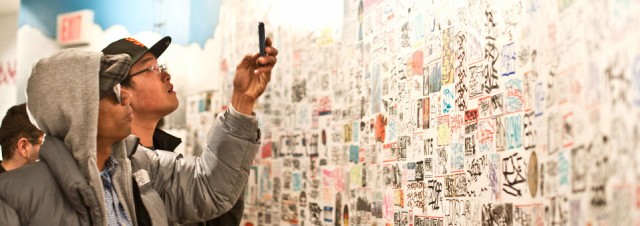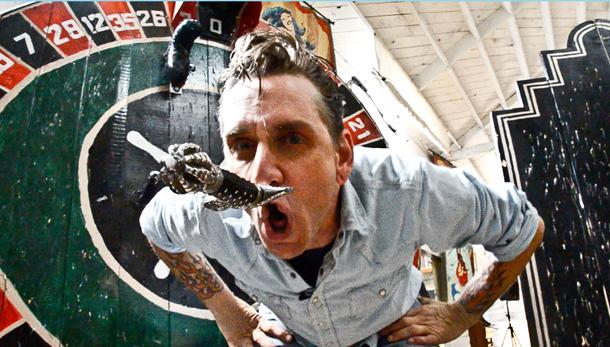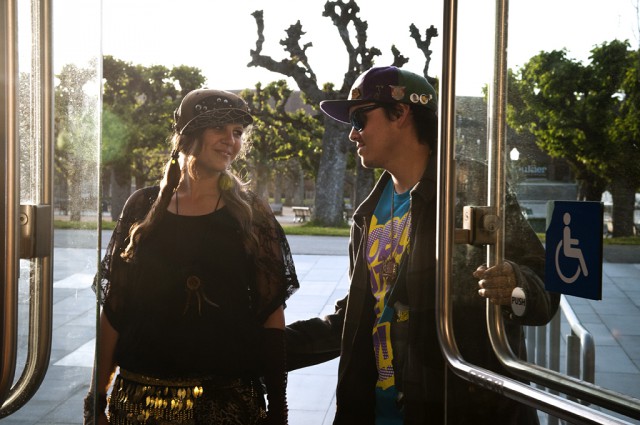
Written by Natalia Vaskez Photo by Samantha Battles
“It’s an entirely selfish art form, obstructing public spaces just to leave your mark on the world, but when we put it all together it looks like a strong community,” says Micah Serias. His large dark eyes scan the stickers, making out the San Francisco skyline. He scans each individual sticker, also known as a “slap,” with its signature design unique to each artist. The latest evolution of street art can be seen in sheets of tiny mail stickers on the bus, on newsstands, benches, and “pretty much anywhere somebody can see your name,” he says. “I’ve seen a slap on the Bay Bridge where people roll close to the wall and just throw up their name.”
Branding public space with the face of the people is nothing new to San Francisco. The city’s rich history of civil disobedience has been reflected in street art since the early sixties and art has often parallelled those movements for social justice. These illegal art installations stand out from the critically acclaimed art of the galleries because of the inherent risks to the artists. But like so many other illegalities, San Francisco allows residents to bend the laws of vandalism and foster creativity throughout the city.
Most recently slap art came to San Francisco State University in a completely unique art gallery, showing in the Cesar Chavez Student Center. Complete with a keg of Pabst Blue Ribbon and brats for every dietary restriction, students listened to a live band and took in the power of street art. Jordon Aydaub, an SFSU student and street artist, organized the event but the stigma of street art made the private owners of the gallery inflict some strict requirements.
“They said I needed to have a certain amount of illustrated pieces, and all these other random requirements,” Aydaub begins to comment before more people come up and congratulate him on the great turnout for the gallery opening.
This stigma within the art world has unarguably lessened through the pioneer work of key artists throughout the last half century. Most notably San Francisco’s Mission District has “the highest concentration of murals per square feet in the country… and some scholars believe an amount which supersedes that of any city in the world,” according to the book Street Art San Francisco: Mission Muralismo. The muralists of the 1960’s were believed to be inspired through Mexican muralist traditions.
“It is not backed by the churches or government,” writes Carlos Santana of growing up among the street art in the Mission District. “But by the people in the community seeking alternative information as a tool to develop awareness and rally people into action.”
This erupted in the 1970s as the entire nation was politically evolved and San Francisco was the back drop for the free love movement. People flocked to the city and covered the streets with art.
“It’s a beautiful juxtaposition between the billboards of downtown and the scribbles over the shut down small businesses,” says Luggage Street art gallery owner Darryl Smith. The entrance to this gallery appears to be merely another victim to the recession in a neighborhood where extreme class disparity lives within blocks of one another. On the corner of Sixth Street is a burger joint and a check cashing place where residents congregate from early in the afternoon to late at night.
Just outside the door stands a man outfitted in a maroon and gold track suit perfectly accessorized by a white and gold head piece and four gold plated teeth he shows off with ear to ear smiles. He is responsible for keeping the people loitering outside from entering. Some of the men on the street approach; looking to buy packs of cigarettes the doorman slings on the side. His speech is hurried and topic jumps from subject to subject in acrobatic leaps and bounds before abandoning the listener completely perform another sale. Not what comes to mind when one thinks of security for a gallery in an unsuspecting place.
The Luggage Store Gallery is not only responsible for the artwork inside the building but for murals in unexpected places. They funded and contacted the muralists for the mural opposing the gallery, as well as their latest installment in the Tenderloin.
“Art is the representation of people, in its purest form,” explains Smith, standing tall and lean with the latest exhibit still undergoing installation behind him.
San Francisco has permitted the murals in front of abandoned street shops to brighten the mood of the latest economic collapse. The Mission is now covered with cries of gentrification, pushing the people who pioneered street art further and further away from the place they once called home.
“These illegal and rapidly executed artworks cut through conventions,” writes Susan Kelk Cervantes, who began the community outreach program, Precita Eyes Muralists.
Cervantes began as a muralist, but after her husband passed away Kelk began teaching street art as a creative outlet to the at risk children of the Mission.
“Our bonding commitment is to respect each other’s contribution and paint what is important to the community,” she says.
When wealth began flocking to the cities, more and more waves of commerce, stores, and billboards came with it. In the 1970s it was estimated that city dwellers saw as many as two thousand advertisements a day. Kelk and others like her painted the walls with their responses.
“Commercial billboards assure we can consume for a better life, but murals insist on a centrality of civic engagement,” says Kelk, explaining about street art.
The same representation and civic engagement was ever present inside the student collaboration of the Slap in the Face art showing. The entrance of the gallery was lined with a creative space where patrons could make their own mark. One volunteer operates a button making station with scrap paper and every colored marker. Another table features personalized stickers. In traditional slap fashion they resemble the common mail sticker but the banner incorporates the name and location of the opening.
“There’s an entire legacy of people on these walls, and there’s been some backlash in the community,” Serias says, his hair bouncing with every gesture of emphatic explanation. He tags under the same name he’d prefer to not to relate to his true identity. Originally from the Bay Area, he explains how San Francisco fosters a sense of individuality despite just being one identity in a slew of stickers vandalising public space.
The alleys remain a canvas of evolving art work. Impermanence is in the nature of this art form. A painting of a girl holding a spray can and wearing a gas mask once prophesied, “The problem with vandalism is eventually they try to frame it in a museum.” She has since been painted over.





